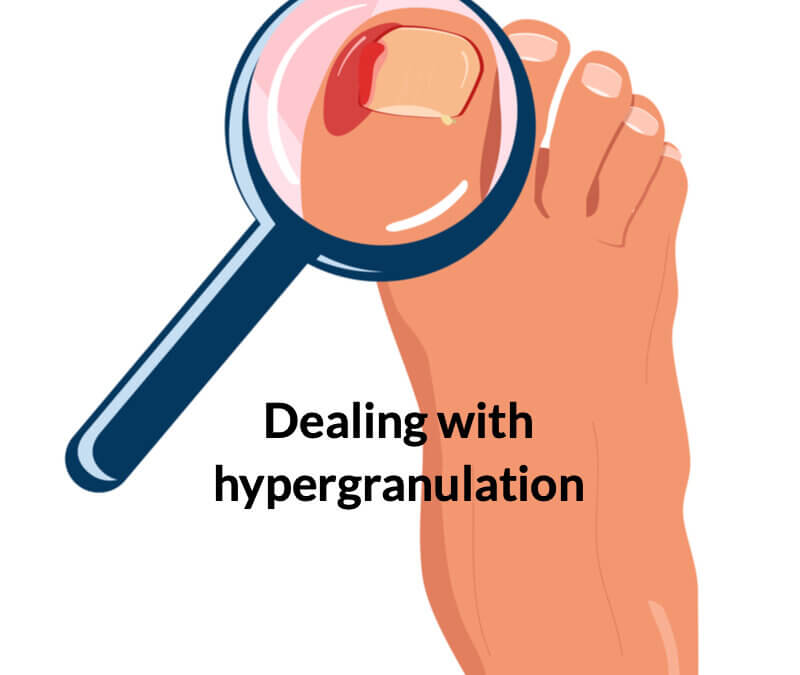Hypergranulation – how good is the latest paper, and why might it be ignored?

Papers can be complex and require time to absorb
The subject discussed is hypergranulation and its management with chemicals. Facebook (I won’t say which site) offers plenty of valuable discussion from members all around. Podiatric Surgeon Ian Reilly saw the trail of questions and answers and wondered why many respondents were unaware of his own paper; Reilly and Burt’s 2021 published in The Podiatrist. Periungual Soft Tissue Resection was published in March/April, so it is fair to say this was not old. My July newsfeed concerns unused resources so this article is associated with the same theme, and so I set out to undertake a reflective review. Reilly and Burt point toward concerns that chemical management of hypergranulation is not as reliable as dissection removal.
Several questions emerge from this reflection article
- Why are readers not aware of quality papers and material
- What information exists, and does it have value-added?
- Analysing article references; are these important?
- How should we treat hypergranulation tissue (HGT) – the crux of the article under discussion.
Lack of awareness
Listening to Radio 4 on 30th June, the conversation concerning meetings went something like ‘…Ministers who go to the meeting don’t bother reading the briefing…’ The subject covered meetings which included the G7 group in Cornwall this summer. A second radio interviewee told the audience, ‘our attention span is even shorter than it once was!’ I googled hypergranulation ingrowing toenails and immediately found that the third post down was both informative and brief. Here’s the best thing, a podiatrist wrote it in Trinidad. At a click of the finger, there is the information, but how good is it? Hit the link and try it out. Is the information clear and is it appropriate for patients or for the profession. Lay or clinically academic?
Value-added
The problem with papers is often their length, their complexity, the time someone is prepared to dedicate to reading, and lastly, their drive and quest to learn more. This ConsultingFootPain article aims at 2000 words in length. The shorter the better. While readers might find an article too long, four key questions are integrated to break the article up.
How long should professionals take to read important information?
Reilly & Burt’s (R&B) article is not a quick read. There is much detail to consider and so a quick glance is insufficient, but it forms a reflective review about the idea that chemical management of HGT may not be as sound as we think. Now if this is the case such an article should not be left for too long to read. How long do we have before it would no longer be acceptable to avoid critical medical, let alone legal concerns? Trying to find this question on Google wasn’t answered, but on the second page, I found ‘The Importance of Professional Reading’ by Richard Bruford (2014). Again this is light, and one would need to dig deeper into those articles that are not high on Search engine optimization (SEO). I went to the member’s site at the Royal College of Podiatrists. There is a link at the end of the R&B article, and it works well enough after navigating for a few minutes. The references associated with R&B’s article are at the bottom of this page.
Analysing the references
 I look first at the abstract and the references. Why? – well, this tells me much about the research and effort someone has gone to increase the value for readers. First, we see 32 references, so we know this has some bulk but does this add to the value of the content? Secondly, what is the oldest and newest reference? The age of references provides how current the author is when collecting information. In the R&B article, the oldest is 1937, and the most recent 2020. Older resources help to identify the nature of investigative work.
I look first at the abstract and the references. Why? – well, this tells me much about the research and effort someone has gone to increase the value for readers. First, we see 32 references, so we know this has some bulk but does this add to the value of the content? Secondly, what is the oldest and newest reference? The age of references provides how current the author is when collecting information. In the R&B article, the oldest is 1937, and the most recent 2020. Older resources help to identify the nature of investigative work.
Turning to the 1937 paper, we can see the value provides an original classification by Heifetz, who breaks ingrown toenail appearance into three stages: erythema & swelling (1), infection and drainage (2) and chronic infection with hypertrophy (3). How exhaustive was the trawl? meaning, was this just English speaking countries? Most authors cannot speak multiple languages at a level to analyse a paper. Personal communication within a reference makes critique tricky because who’s to say that a piece of information is not of value in oral form. However, just from the references alone, Haneke wrote an article in 2013 and a discussion followed in 2020. So the personal communication is valid and not a throw-away or misplaced effort just to make up the reference list.
Primary quotes vs secondary quotes
As a professional reviewer, I test the narrative and look at claims. For example, R&B say, ‘IGTN is estimated to yield up to 10,000 cases per year in the UK (Rounding and Hulm 2001)’ This is wrong. Rounding and Hulm did not say that; it was Sykes 1986, 15 years earlier! Rounding and Hulm quoted Sykes. How do we know Sykes provided this statistic and not someone else? We don’t unless we search Sykes. How do I know Sykes existed. I read Rounding and Hulm’s paper and found Sykes in the references.
How serious is this omission? The use of secondary referencing is acceptable, although if undertaken at higher levels, including publication in a book, then the primary reference might have been included. Undertaking a university library search did not reveal Sykes; the subject of HGT and resection is the focus, and a quote of 10,000 was an estimate anyway. In my view this omission is fine.
How do we treat HGT?
 The best way to learn is through case documentaries. This method sets a scene that relates to the subject, that being HGT. R&B use eight studies and include some graphic pictures. The focus is on whether phenol or silver nitrate (AgNO3) can eradicate the HGT. R&B use sharp dissection at an advanced podiatric level (Fellowship – RCPodS), providing them with the additional skills and awareness of the limitations in general practice.
The best way to learn is through case documentaries. This method sets a scene that relates to the subject, that being HGT. R&B use eight studies and include some graphic pictures. The focus is on whether phenol or silver nitrate (AgNO3) can eradicate the HGT. R&B use sharp dissection at an advanced podiatric level (Fellowship – RCPodS), providing them with the additional skills and awareness of the limitations in general practice.
What motivates the authors is the concern that chemical destruction might not be as efficient as surgical excision. The basis of this comes from their case histories. An additional feature of inadequate periungual resection is the fact that resolution may be lacking and regrowth likely. R&B provide a reference, albeit older from Kang et al. 2008. The reader with experience in nail surgery may have no problems. Still, Facebook highlights that newer recruits are less confident when they view lesions with the magnitude that some hypergranulation develops. The complete loss of the end of the toe to hypergranulation is less common but may involve deeper abscesses. In one such case, this author (DT) had to not only excise the tissue by sharp dissection but remove some of the phalanx. The toe had swollen by 100%, and three months down the line, the toe looked normal again, displaying little trouble for the aggressive debridement.
R&B quote Huang (2020), where the importance of this information reminds us that tissue can change into malignant neoplasia. In the 21st century, podiatrists qualified to undertake nail surgery cannot sit back on past expectations that chemical destruction is valid. Soft tissue malignancy is much more common in the foot than bone malignancy. An eminent Belgian dermatologist presented an excellent talk to podiatrists in Tel Aviv in 2016 which I was invited to speak. He was keen to resect and re-fashion hypertrophic toes. My sponsor, a podiatrist, decided it was vital for her to travel to Belgium to learn these techniques. This action is called reflective practice – a recognition that you must always aim for the best. Reflection is about acceptance and then taking action.
Conclusion
Articles of merit offered by Reilly and Burt should be read by all podiatrists, even those not undertaking surgery. My only criticism comes from the fact that the title could invite more to read it. The title could have been

are chemicals enough for hypergranulation?
Are we doing the best for our patients with ingrown toenails?
Periungual soft tissue sounds professional and engaging, but it might just be that we are trying to be too complex in a publication not designed for higher academic merit. Negative criticism is not intended of the authors who have brought to light an important piece of reflective information, but maybe the membership requirements have yet to be finalised. My hope is that this piece of work will not be lost to the annals of time and decay. More information on IGTN can be found on this site Ingrown Toenails
![]()
Used by R&B 2021
- Antrum RM. (1984) Radical excision of the nail fold for ingrowing. The Journal of Bone and Joint Surgery (British Volume). 66(1): 63-5.
- Boberg JS, Frederiksen MS, Harton FM. (2002) Scientific analysis of phenol nail surgery. Journal of the American Podiatric Medical Association 92(10): 575-9.
- Chapeskie H, Kovac JR. (2010) Soft-tissue nail-fold excision: a definitive treatment for ingrown toenails. Canadian Journal of Surgery 53(4): 282-6.
- De Almeida Figueiras D, Ramos TB, de Oliveira Ferreira Marinho AK, Bezerra MSM, Cauas RC. (2016) Paronychia and granulation tissue formation during treatment with isotretinoin. Anais Brasileiros de Dermatologia 91(2): 223-5.
- DeBrule MB. (2015) Operative treatment of ingrown toenails by nail fold resection without matricectomy. Journal of the American Podiatric Medical Association 105(4): 295-301.
- Eekhof JAH, Van Wijk B, Knuistingh Neven A, van der Wouden JC. (2012) Interventions for ingrowing toenails. Cochrane Database of Systematic Reviews 4. See: https://www.cochranelibrary.com/cdsr/doi/10.1002/14651858.CD001541.pub3/full (accessed 27 January 2021).
- Erdogan FG. (2006) A simple, pain-free treatment for ingrown toenails complicated with granulation tissue. Dermatologic Surgery 32(11): 1388-90.
- Haneke E. (2020) Personal communication.
- Haneke E. (2013) Nail surgery. Clinics in Dermatology 31(5): 516-25.
- Harada K, Yamaguchi M, Matsuzawa M, Shimada, S. (2015) Ingrown nail with a giant granulation tissue successfully treated with the gutter method. International Journal of Dermatology 54(5): e191-2.
- Heidelbaugh JJ, Lee H. (2009) Management of the ingrown toenail. American Family Physician 79(4): 303-8.
- Heifetz CJ. (1937) Ingrown toenail. American Journal of Surgery 38(2): 298-315.
- Huang C.-K. (2020). Case study. Ingrowing cancer. Podiatry Now 23(9): 33-5.
- Kang MH, Seo YJ, Park EJ, Kim CW, Jo HJ, Kim KH, Kim KJ. (2008) The effect of removal of granulation tissue on ingrown toenails associated with granulation tissue. Korean Journal of Dermatology 46(4): 453-8.
- Laco JE. (1994) Nail surgery. In: Hetherington VJ (ed). Hallux Valgus and Forefoot Surgery. Churchill Livingstone: London: 481-96.
- Livingston MH, Coriolano K, Jones SA. (2017) Nonrandomised assessment of ingrown toenails treated with excision of skinfold rather than toenail (NAILTEST): An observational study of the Vandenbos procedure. Journal of Pediatric Surgery 52(5): 832-6.
- Lloyd‐Davies RW, Brill GC. (1963) The aetiology and out-patient management of ingrowing toenails. British Journal of Surgery 50(224): 592-7.
- Markinson B. (2020) Personal communication.
- Martínez-Nova A, Sánchez-Rodríguez R, Alonso-Peña D. (2007) A new onychocryptosis classification and treatment plan. Journal of the American Podiatric Medical Association 97(5): 389-93.
- Mousavi SR, Khoshnevice J. (2012) A new surgical technique for ingrown toenail. ISRN Surgery 2012: 338915.
- Mozena JD. (1992) The Mozena Classification System and treatment algorithm for ingrown hallux nails. Journal of the American Podiatric Medical Association 92(3): 131-5.
- Park DH, Singh D. (2012) The management of ingrowing toenails. BMJ 344: e2089.
- Perez CI, Maul XA, Heusser MC, Zavala A. (2013) Operative technique with rapid recovery for ingrown nails with granulation tissue formation in childhood. Dermatologic Surgery 39(3 Pt 1): 393-7.
- Persichetti P, Simone P, Li Vecchi G, Di Lella F, Cagli B, Marangi GF. (2004) Wedge excision of the nail fold in the treatment of ingrown toenail. Annals of Plastic Surgery 52(6): 617-20.
- Reilly IN. (2019) Continuing Professional Development: nail surgery. Podiatry Now 22(11): supplement.
- Reyzelman AM, Trombello KA, Vayser DJ, Armstrong DG, Harkless LB. (2000) Are antibiotics necessary in the treatment of locally infected ingrown toenails? Archives of Family Medicine 9(9): 930-2.
- Richert B. (2011) Surgery of the lateral nail folds. In: Richert B, Di Chiacchio N, Haneke E. (eds). Nail Surgery. CRC Press: Boca Raton FL.
- Rounding C, Hulm S. (2001) Surgical treatments for ingrowing toenails. Foot 113: 166-82.
- Terrill AJ, Green KJ, Salerno A, Butterworth PA. (2020) Risk factors for infection following ingrowing toenail surgery: a retrospective cohort study. Journal of Foot and Ankle Research 13: 48.
- Vandenbos KQ, Bowers WF. (1959) Ingrown toenail: a result of weight bearing on soft tissue. Armed Forces Medical Journal 10(10): 1168-73.
- Winograd AM. (1929) A modification in the technic of operation for ingrown toenail. Journal of the American Medical Association 92(3): 229-30.
- Zadik, F. R. (1950). Obliteration of the nail bed of the great toe without shortening the terminal phalanx. Journal of Bone and Joint Surgery (Br) 32(1): 66-7.
Thanks for reading ‘Are chemicals enough for hypergranulation?’ by David R Tollafield
Published by Busypencilcase Reflective Communications Est. 2015


Recent Comments